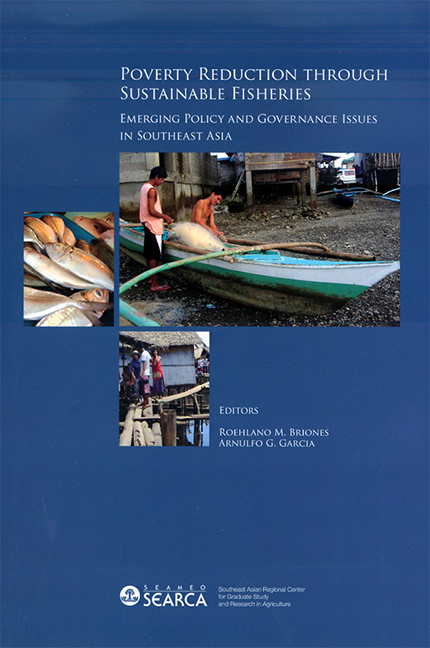 Poverty Reduction through Sustainable Fisheries
Poverty Reduction through Sustainable Fisheries Book contents
- Frontmatter
- Contents
- Figures
- Tables
- Foreword
- Acknowledgments
- 1 Introduction and Synthesis
- 2 Fish and the Poor
- 3 Fish and the Poor: The Case of Cambodia
- 4 Changing Demand and Supply Structure of Fish in Asia: Past Trends and Future Projections
- 5 Regional Economic Integration of the Fisheries Sector in ASEAN Countries
- 6 Technology Policies for Capture Fisheries and Aquaculture in Southeast Asia
- 7 The Status, Current Trends and Future Directions for Production and Technology of Fisheries in Southeast Asia
- 8 The Seafood Supply Chain and Poverty Reduction
- 9 Strategy for the Empowerment of Aquaculture Fish Farmers in Indonesia
- 10 Status of Coastal and Marine Resources: Implications for Fisheries Management and Poverty in Southeast Asia
- 11 Property Rights and Institutional Arrangements in Southeast Asian Fisheries
- 12 Regional Cooperation in Aquatic Resource Management for Southeast Asia
9 - Strategy for the Empowerment of Aquaculture Fish Farmers in Indonesia
Published online by Cambridge University Press: 21 October 2015
- Frontmatter
- Contents
- Figures
- Tables
- Foreword
- Acknowledgments
- 1 Introduction and Synthesis
- 2 Fish and the Poor
- 3 Fish and the Poor: The Case of Cambodia
- 4 Changing Demand and Supply Structure of Fish in Asia: Past Trends and Future Projections
- 5 Regional Economic Integration of the Fisheries Sector in ASEAN Countries
- 6 Technology Policies for Capture Fisheries and Aquaculture in Southeast Asia
- 7 The Status, Current Trends and Future Directions for Production and Technology of Fisheries in Southeast Asia
- 8 The Seafood Supply Chain and Poverty Reduction
- 9 Strategy for the Empowerment of Aquaculture Fish Farmers in Indonesia
- 10 Status of Coastal and Marine Resources: Implications for Fisheries Management and Poverty in Southeast Asia
- 11 Property Rights and Institutional Arrangements in Southeast Asian Fisheries
- 12 Regional Cooperation in Aquatic Resource Management for Southeast Asia
Summary
INTRODUCTION
Background
Indonesia is the largest archipelagic country in the world, with high diversity in terms of geography and climate, ecosystems, and species. These extensive and varied natural resources have great potential for developing a wide spectrum of fisheries activities. The population of over 220 million is predominantly young, with a relatively large proportion that are of working age. Majority still live in rural areas (both inland and coastal), and most ethnic groups have maintained strong farming traditions conducive for conversion to or development of fisheries, including aquaculture activities. Indonesia can become a major world player in the fisheries sector, based on both natural and human resources.
The Indonesian aquaculture sector is still dominated by small-scale business units, mainly in rural areas and often in remote settings. Previous development cycle statistics (2000-2004) show that 63 per cent of poverty and 42 per cent of declared unemployment occurred in rural areas. The predominantly rural aquaculture sector can play an increasingly important role in achieving three of the national pillars of development: (1) growth (pro-growth); (2) expansion of employment opportunities (pro-job); and (3) poverty reduction (pro-poor).
The president of the Republic of Indonesia launched the Revitalisation of Aquaculture Program on June 11, 2005, as part of the Revitalisation of Agriculture, Fisheries and Forestry Program. Under the program for 2006-2009, three products have been launched as main fisheries commodities for revitalisation: (1) tuna, (2) prawn/shrimp, and (3) seaweed, with shrimp and seaweed being classified under aquaculture. Eight additional strategic commodities are being given special attention: tilapia, grouper, milkfish, pangasius, catfish, gourame, abalone, and ornamental fish. Seaweed is one of the fastest-growing export commodities; from a cultural point of view, it has proven to be a well-adapted economic activity that can improve livelihoods of many coastal communities. The Aquaculture Revitalisation Programme has increased aquaculture production by as high as 24 per cent in 2006. In 2007, aquaculture production was expected to increase by 38 per cent.
- Type
- Chapter
- Information
- Poverty Reduction through Sustainable FisheriesEmerging Policy and Governance Issues in Southeast Asia, pp. 189 - 198Publisher: ISEAS–Yusof Ishak InstitutePrint publication year: 2008


